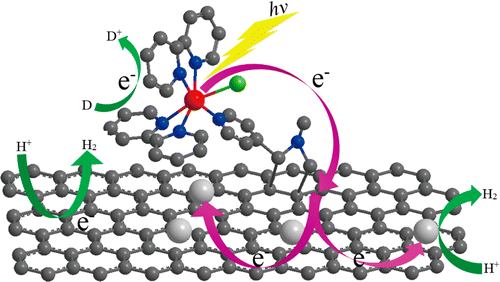Improved Superiority by Covalently Binding Dye to Graphene for Hydrogen Evolution from Water under Visible-Light Irradiation
Bin Xiao †, Xiaomei Wang ‡, Hui Huang †, Mingshan Zhu §, Ping Yang *†(杨平), Yong Wang *†(王勇), and Yukou Du †
†
‡
§ CAS Key Laboratory of Colloid, Interface and Chemical Thermodynamics Institute of Chemistry, Chinese Academy of Sciences, Beijing 100190, China
J. Phys. Chem. C 2013, 117, 21303–21311
A novel nanohybrid composed of bipyridine ruthenium complex ((2,2′-bipyridyl)-4-pyridyl-chloro-ruthenium(II), Ru(bpy)2(py)Cl), covalently functionalized graphene (Ru(bpy)2(py)Cl/G), has been synthesized successfully via coordination of Ru(bpy)2Cl2 with pyridine covalently functionalized graphene (py/G), which was synthesized through 1,3-dipolar cycloaddition of azomethine ylides. Ru(bpy)2(py)Cl/G was characterized by atomic force microscopy (AFM), scanning electron microscopy (SEM), transmission electron microscopy (TEM), Raman spectra, Fourier transform infrared (FTIR), and ultraviolet–visible absorption (UV–vis). The fluorescence quenching efficiency of the nanohybrid excited at 290 and 535 nm was calculated to be 83% and 71%, respectively. The photocurrent density of the nanohybrid also significantly improved. The results revealed that fast photoinduced electron transfer from Ru(bpy)2(py)Cl moiety to graphene sheet occurred. Ru(bpy)2(py)Cl/G modified with platinum nanoparticles demonstrates remarkable enhanced photocatalytic activity for hydrogen evolution from water. Under 10 h UV–vis or visible light irradiation (>400 nm), the total amount of H2 evolution was 39.3 and 7.6 μmol mg–1, respectively. In addition, Ru(bpy)2(py)Cl/G/Pt nanohybrid shows sufficient stability for photocatalytic H2 evolution, and the hydrogen yield remains virtually unchanged in 50 h of irradiation. This study suggests that the carbon based nanohybrid composed of organic dye molecules covalently functionalized graphene is a promising candidate as a novel photocatalyst for photocatalytic hydrogen evolution.

链接: //pubs.acs.org/doi/abs/10.1021/jp405497j